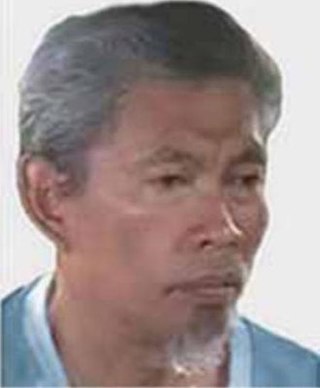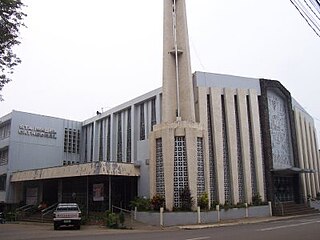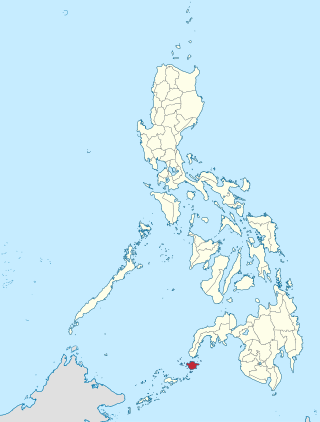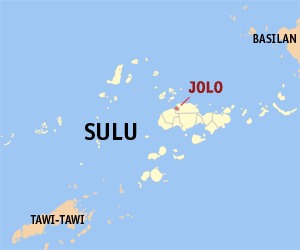
Abu Sayyaf, officially known by the Islamic State as the Islamic State – East Asia Province, is a Jihadist militant and pirate group that followed the Wahhabi doctrine of Sunni Islam. It was based in and around Jolo and Basilan islands in the southwestern part of the Philippines, where for more than five decades, Moro groups had been engaged in an insurgency seeking to make Moro Province independent. The group was considered violent and was responsible for the Philippines' worst terrorist attack, the bombing of MV Superferry 14 in 2004, which killed 116 people. The name of the group was derived from Arabic abu, and sayyaf. As of April 2023, the group was estimated to have about 20 members, down from 1,250 in 2000. They used mostly improvised explosive devices, mortars and automatic rifles.

Khadaffy Abubakar Janjalani was a Filipino Islamist militant who was the leader of the Moro militant group known as Abu Sayyaf and the leader of one of its factions. He was a staunch Wahhabi follower.
The Dos Palmas kidnappings was a hostage crisis in southern Philippines that began with the seizing of twenty hostages from the affluent Dos Palmas Resort on a private island in Honda Bay, Palawan, by members of Abu Sayyaf on May 27, 2001, and resulted in the deaths of at least five of the original hostages. Three of these hostages were American citizens, Guillermo Sobero, and a married missionary couple, Gracia and Martin Burnham. At least 22 Filipino soldiers were killed in attempts to apprehend the captors and free the hostages in the 12 months following the initial hostage taking. An unknown number of captors were killed by government forces.
Abu Sabaya, born Aldam Tilao, was one of the leaders of the Abu Sayyaf in the southern Philippines until he was shot down by soldiers of the Armed Forces of the Philippines in 2002.

The Moro conflict was an insurgency in the Mindanao region of the Philippines which involved multiple armed groups. Peace deals have been signed between the Philippine government and two major armed groups, the Moro National Liberation Front (MNLF) and the Moro Islamic Liberation Front (MILF), but other smaller armed groups continue to exist. In 2017, the peace council settled around 138 clan conflicts.

Isnilon Totoni Hapilon, also known by the nom de guerreAbu Abdullah al-Filipini, was a Filipino Islamist militant affiliated with ISIS. He was formerly leader of Abu Sayyaf Group, before its battalions pledged their allegiance to Abu Bakr al-Baghdadi. An April 2016 issue of ISIL's weekly newsletter Al Naba said that Hapilon had been appointed as "emir of all Islamic State forces in the Philippines".

Radullan Sahiron is a Filipino Islamic militant who is the leader of Abu Sayyaf. He is said to have taken command of the organization following the death of Khadaffy Janjalani in September 2006.

The Territorial Prelature of Isabela (de Basilan) (Latin: Praelatura Territorialis Isabellapolitana) is a Roman Catholic territorial prelature located in the province of Basilan, and its component cities of Isabela City and Lamitan City, in the ecclesiastical province of Zamboanga in the Philippines.
1994 in the Philippines details events of note that happened in the Philippines in the year 1994.
The civil conflict in the Philippines as of February 2019, consists of an insurgency pitting government forces against Maoist rebels, that began in 1969 during the rule of Ferdinand Marcos.
The 2000 Sipadan kidnappings was a hostage crisis in Sabah, Malaysia, and the southern Philippines that began with the seizing of twenty-one hostages from the dive resort island of Sipadan at approximately 6:15 p.m. on 23 April 2000, by up to six Abu Sayyaf (ASG) bandits. Taken hostage were 10 tourists from Europe and the Middle East and 11 Malaysian resort workers, 19 non-Filipino nationals in total. The hostages were taken to an Abu Sayyaf base in Jolo, Sulu.

The Battle of Tipo-Tipo was a military engagement that began on 9 April 2016 at Tipo-Tipo, Basilan Island, Philippines between forces of the Philippine Army and members of the Abu Sayyaf militant group. The battle resulted in dozens of casualties, with at least 18 soldiers and 31 militants reported killed, and more than 70 others injured. It was the largest single loss of life for the Philippine Army since the beginning of the year, and came just a day after the group had released an Italian hostage.

Noel S. Buan is a retired Philippine Army general officer and a recipient the Philippines' highest military award for courage – the Medal of Valor. Buan was captured and held by the communist New People's Army in July 1999 while serving as an intelligence officer with the Armed Forces of the Philippines Southern Luzon Command. He was released after 21 months of captivity in April 2001. In 2004, while serving as commander of the 1st Scout Ranger Battalion in Basilan, Buan orchestrated a military operation that resulted in the deaths of Abu Sayyaf leader Hamsiraji Marusi Sali and his brother Sahir.
This article contains a timeline of events from January 2016 to December 2016 related to the IS-linked Abu Sayyaf. This article contains information about the events committed by or on behalf of the Abu Sayyaf, as well as events performed by groups who oppose them.
The following is a list of attacks which have been carried out by Abu Sayyaf, a militant group based in and around Jolo and Basilan islands in the southwestern part of the Philippines, where for more than four decades, Moro groups have been engaged in an insurgency for an independent province in the country.

The 2017 Bohol clashes were armed conflicts that took place in April and May 2017 between Philippine security forces and Moro ISIL-affiliated militants led by members of the Abu Sayyaf in Inabanga, Bohol, Philippines. Three Philippine Army soldiers, a policeman, four terrorists and two civilians were killed during the initial firefight. Subsequent firefights between the remaining militants and security forces resulted in the deaths of all the Abu Sayyaf insurgents. A ranking officer of the Philippine National Police linked to Abu Sayyaf attempted to rescue some of the insurgents but was arrested.

The Summer 2016Sulu and Basilan clashes were armed conflicts that took place in two battlefronts on the southern islands of Mindanao, Philippines from 21 June to 12 July.
This is a chronology of the Moro conflict, an ongoing armed conflict in the southern Philippines between jihadist groups such as the Abu Sayyaf Group, the Maute Group, Jemaah Islamiyah, and Islamic State affiliates, mainstream separatist groups such as the Moro Islamic Liberation Front (MILF), the Moro National Liberation Front (MNLF) and the Bangsamoro Islamic Freedom Fighters (BIFF), and the Philippine Government since 1971. Much of the fighting has been concentrated on the island of Mindanao and the Sulu archipelago, with spillover incidents and attacks occurring in the Philippine capital Manila and neighboring countries such as Malaysia.

Ariel Oliva Querubin is a retired Philippine Marine Corps officer and a recipient of the Philippines' highest military award for courage, the Medal of Valor. He is the most decorated soldier in the Philippines.
On July 31, 2018, a bomb exploded in the town of Lamitan in Basilan, Philippines.











